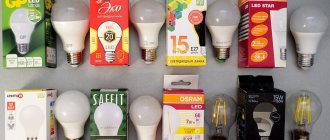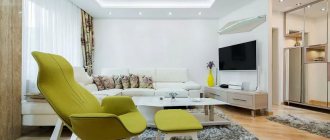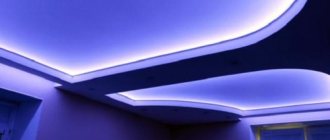If the hardware is familiar: light absorption and reflection coefficients, color rendering index, why ceiling height is important, etc., then go straight to point 5. There we have collected quick ways to calculate illumination. If you do come across unfamiliar words, then spend 30 minutes getting to know the topic now so as not to spend over your budget on repairs later.
Why is it important? Not to mention the fact that dim light spoils vision, and too bright light makes you nervous, lighting is also an inspiration for space. Imagine you spend two weeks choosing a sofa of a certain alabaster shade. You wait another two weeks for delivery, because, of course, there is no such sofa in stock. Finally a sofa at home. You are putting the finishing touches: screwing a light bulb into the floor lamp near the sofa and turning it on. And then your alabaster sofa turns into a stain the color of a dirty puddle.
Remember, an expensive renovation with ill-conceived lighting will look worse than an inexpensive one with beneficial light.
Main conclusions
Artificial light is of great importance for humans; it should resemble natural light as much as possible. Otherwise, the person suffers from headaches, drowsiness, irritability, decreased performance, and blurred vision. To avoid this, you need to find out how many lumens per 1 m² you need. To do this, you should study the illumination standards of a certain room, do not confuse Lm with Lk and carefully carry out the calculation. Then you can correctly determine the number of lighting fixtures for uniform illumination. To adjust the brightness of the light, install a separate switch for each lamp.
Previous
Lighting in an apartmentBasic methods of organizing and installing staircase lighting in a private house
Next
Lighting in the apartmentHow to properly organize and distribute lighting in the apartment
Online calculator from Light Technologies
Online calculator from lighting technologies
This version of the program is suitable for simple lighting design - it does not require installation on a laptop or computer, so you can immediately start calculations. But, at the same time, its functionality is minimal; the software takes into account the smallest number of parameters and provides only the main characteristics of the future object. Located on the next page:
https://www.ltcompany.com/ru/solutions/illumination-calculator/
Ratio Watt, Lumen, Lux
Just 10 years ago, it was easier to choose a suitable light bulb, since the maximum power was indicated on each device. Nowadays, filament-based devices are being replaced by energy-saving ones, the power values of which have completely changed. Now, when choosing lamps, you should take into account the illumination (Lx) and luminous flux (Lm).
Interesting! Some people continue to choose light bulbs based on power, but this is not true. Watts indicate the amount of energy a fixture consumes, but does not indicate the level of luminous flux.
To determine the amount of light, you need to pay attention to Lux and Lumen. Many consumers still confuse these important meanings. The first indicator indicates the surface on which the light falls, and the second indicates the luminous flux of the light bulb. A device with a light power of 1 Lumen qualitatively illuminates 1 m², creating an illumination of 1 Lux. That is, Lk shows the ratio of the amount of Lm and the illuminated area.
Below is a table that helps convert Watts into lumens for different types of lamps:
| Filament lamp, power (W) | Luminescent, power (W) | LED, power (W) | Luminous power (Lumens) |
| 20 | 5 – 7 | 2 – 3 | Up to 250 |
| 40 | 10 – 13 | 4 – 5 | Up to 400 |
| 60 | 15 – 16 | 8 – 10 | Up to 700 |
| 75 | 18 – 20 | 10 – 12 | Up to 1000 |
| 100 | 25 – 30 | 12 – 15 | Up to 1300 |
| 150 | 40 – 50 | 18 – 20 | Before 1800 |
| 200 | 60 – 80 | 25 – 30 | Up to 2500 |
This table shows that the energy requirements of different types of appliances are different. However, it shows only approximate parameters that can be used to find out how many lumens are needed per 1 m².
For approximately 1 Watt of energy consumed, a conventional light bulb can emit 8 – 2 Lm. This difference can be caused by many reasons, for example, the devices are made of different materials, they are damaged during transportation, etc.
This is interesting! The illumination standards that Russia is guided by were adopted a long time ago, so often calculations using them do not bring the desired result, that is, there is not enough light. To avoid this, when determining the number of lumens per 1 m², it is recommended to increase all values by 1.5 times. For convenience, it is worth installing several switches in the room for different lamps to regulate the light intensity.
Independent calculation of the required amount of light and lighting fixtures
To obtain uniform illumination, you need to calculate the total power (electric or light), the number of lamps and luminaires. The calculation must be made taking into account the following factors:
- Type of room (bedroom, bathroom, office).
- Ceiling height.
- Color scheme of walls, furniture and floors.
- Presence of a mirror.
The level of lighting per square meter depends on the functional purpose of the room. What is good for a bedroom is too dim for a living room or kitchen, and vice versa.
Attention! To find out how many Lumens are needed per 1 m², you should take into account the height of the ceilings. The standard for calculations is a height of up to 3m. If this indicator ranges from 3 to 4 m, then multiply the result by 1.5, and if more than 4 m, multiply by 2.
There are two ways to calculate the amount of light for a specific room:
- Taking into account electrical power.
- By luminous power.
For each method, different standard values, formulas, and units of measurement are used.
Calculating illumination taking into account electrical power is a simple but not very accurate method. To carry it out, you need to know the area of the room and the required number of watts per square meter. To calculate the area, use the formula: S = a x b. Then multiply the required number of W per 1 m² (on average this figure is 20 W) by the area. For this, the following formula is used: P (total power) = S x P (nominal power for 1 m²).
You can then determine the number of fixtures for the room. To do this, divide the total power by this value for one light source. For example, if you need to illuminate a room with a total power of 300 W using lamps with a 75 W filament, then carry out the calculation: 300 : 75 = 4. That is, for illumination you need 4 75 W lamps.
Experts say that the 20 W standard is not accurate. To make the calculations correctly, use separate values for different rooms: for the living room - from 10 to 35 W, for the kitchen - from 12 to 40 W, for the bathroom - from 10 to 30 W, for the bedroom - from 10 to 20 W. This data is for filament lamps. If you want to use housekeepers, then pay attention to the packaging, which indicates what power of a regular lamp this device corresponds to.
Experts advise carrying out calculations taking into account the luminous flux (Lm). This method gives more accurate results, although not all people are used to it. To find out how many Lumens are needed per 1 m², you need to know the lighting standards for a particular room.
Organization of lighting in residential premises
Using lighting fixtures, you can evenly illuminate the entire room and divide it into separate zones (desktop, lounge chair, mirror, etc.). Previously, it was believed that in order to organize high-quality lighting, you only need to know the number of watts per square meter, but this opinion is outdated. To make correct calculations, it is necessary to determine how many Lx and Lm are needed per 1 m². Taking these important parameters into account, you can decide on the number of light bulbs and fixtures.
When organizing lighting, you need to take into account the characteristics of individual residential premises:
- In the hallway, artificial lighting is necessary, since there are usually no windows. For illumination, you can use lamps that emit a directed beam of light with a wide scattering angle.
- The living room is the most functional room, which can combine an area for relaxation, work, sports, eating, etc. Multi-level lighting is used here using different types of devices: ceiling, wall, table, floor. They will help to evenly illuminate the room and highlight individual functional areas. To focus attention on the interior features, luminous strips are used.
- The kitchen has 2 main “luminous” centers - a dining table and a work surface. A ceiling light will help illuminate the eating area, and spotlights or LED strips are used to illuminate the cutting table.
- The bedroom is a place for rest and relaxation, so the light in it should be soft and warm. A small chandelier or spotlights act as background lighting. You can complement it with lamps near the bed or dressing table.
This is interesting! In the bedroom, it is recommended to install lamps with a dimmer to increase or decrease the light intensity if desired.
In bathrooms you can combine background and local lighting fixtures. The main device is installed on the ceiling or wall, and additional devices are installed near the mirror, washbasin, etc. For the bathroom, it is worth buying devices with a high level of moisture protection.
Light-in-Night
Light-in-Night
This is a program for mobile devices, it allows you to design outdoor lighting directly on your smartphone. It is distributed in free form, anyone can download this application. Functionally, the software is made in the form of a designer, where you can specify an object template (street, stadium, park) and place lamps in installation locations. Based on the simulation results, you will receive a three-dimensional image with data on the level of illumination at various points.
You can download here: https://play.google.com/store/apps/details?id=ru.galad.lin
Types of lamps
This is the name given to a device for directing light radiation at a certain angle. The type of device affects the transformation of the flow; it can be internally reflected, distorted, refracted, or limited. They are distinguished by the degree of angular concentration, taking into account the amplification coefficient.
There are types of lamps:
- ceiling;
- wall;
- floor;
- external suspended, on the ground.
Ceiling chandeliers provide the main luminous flux and are the most common. These include chandeliers, built-in, pendant, spot, track, LED panels and strips. Overhead types, sconces, and different types of lighting for pictures or mirrors are placed on the wall. They have hidden wiring, and the models themselves are produced with horns, flat ones, and a combination of different styles.
Tabletop types are usually represented by a base with a vertical rod on which a lampshade or a modern lampshade is installed. More often they are made portable, sometimes fixed on a table panel. Models are made in a special style, sometimes in the form of figures, recognizable objects.
Floor and ground lamps are represented by floor lamps and vertical stands. They have lampshades, which can be open or closed on top. The materials for the body are glass, crystal, metal, aluminum, bronze.
Some nuances
The given calculation formulas give average indicators, so they can be slightly reduced. For example, if a room is rarely visited (pantry, corridor), then the number of light bulbs can be slightly reduced, but for frequently used ones (children's room, living room, kitchen), a slight excess of the calculated norm is allowed. In addition, you can use combined lighting, which allows you to additionally illuminate a certain area of the room. As you can see, the calculations are not so complicated, but they are necessary for your health and comfortable time at home.
Innovative devices
More and more people are changing their choice from traditional incandescent lamps in favor of LED lamps. They, some time ago, were considered unacceptable light sources that could be used in an apartment or house. With the growth of production capacity and science, they began to pose significant competition to standard lighting devices.
Their ability to compete is explained by the following factors:
- The service life of the lamp is much longer compared to a conventional one;
- LED lamp consumes less energy than halogen and incandescent lamps;
- The LED lamp does not heat up when used for a long time, which allows it to be used better and more creatively in interior design.
If previously this device did not have the opportunity to compete with other lighting devices, now the manufacturers have tried. The market is saturated with lamps of various lighting levels, energy consumption and spectrum. Anyone can purchase exactly the product they need.
An important role is played by the fact that LED lamps are more environmentally friendly than their predecessors. They do not create fluctuations in the light flux, and they do not emit ultraviolet radiation.
Many experts advise using LED lamps when planning a room. However, it is necessary to take into account the fact that it is possible to purchase low-quality products. When purchasing a product, it is recommended to pay attention to the manufacturer's brand. As a rule, the more famous it is, the higher quality products it produces.
Warm or cold
Natural daylight has a warm spectrum. It is comfortable for the eyes and body. But manufacturers produce lamps with a cold and warm spectrum, which have their own effect on the body.
Natural and LED lighting
Let's note the most important points:
- According to the standards, cold glow is recommended for work areas. It increases concentration and tones the body.
- A warm glow is installed in the relaxation areas. According to the norms, it helps to relax and calm down.
- Neutral light is the best option for a children's room and for any other room.
Comparative characteristics
It is important to take into account that the yellow and blue spectrum distort color perception, unlike natural light.
On the packaging, the light temperature is indicated in Kelvin (K). The yellow (warm) spectrum ranges from 2700–3500 K. The blue (cool) spectrum ranges from 5000–5400 K. Average values refer to natural (neutral) light.
Ulysses
Ulysse program
This program also allows you to calculate lighting systems. Widely used for lighting calculations for various objects. It also provides the user with a rather interesting set of tools for calculating street lighting and other lighting parameters. A good advantage of this program is the ability to take into account natural light and its influence on the result as a whole along the perimeter of the room or area.
This software product is presented by Schreder; today it has already undergone many improvements and boasts fairly accurate calculations.











